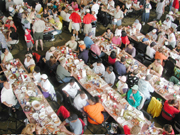Annapolis Rotary Passes the Buck
Crab eaters satisfy their appetites and nourish Annapolis community projects
by Carrie Steele with Ralph Camardo
At the Rotary Crab feast on August 4, hungry crab eaters will devour their crabs in three hours. The crowd — last year some 2,400 people — squares off the meal with barbeque, corn on the cob, crab soup and lots more. Dining on paper-covered picnic tables lined up like a military mess hall, crab pickers share in bushels of hard-shelled crustaceans seasoned with Old Bay, butter and often vinegar, snuck in purses.
Nourishment comes by the bushel, and local non-profits get nourished, too, but with funding.
The feast raises tens of thousands of dollars each year that goes directly to non-profits and local charities. Last year’s feast raised $43,500. Forty-seven grant applicants vied for a piece of that pie, seeking more than $200,000.
Eight months after the night of the feast — which featured some 390 bushels of crabs, 3,400 ears of corn, 130 gallons of crab soup, 1,800 hot dogs and 150 pounds of beef barbecue — 20 area organizations won slices of that pie.
It helps a group to have a well-written grant application, reports Annapolis Rotary president Eric Edstrom. But “sometimes new organizations that aren’t experienced at writing grants don’t articulate, but it’s so clear that they’re meeting a need of the community.”
Grants are “based on what they ask for,” says crab feast chairman Scott Kerridge. “Some people ask for $500 and some ask for $25,000.”
The largest grant awarded with last year’s funds was $5,000, won by Mid-Atlantic Cancer Support Center. That’s the largest grant Rotary will award, according to Edstrom.
“The purpose is to touch as many organizations as we can,” he said.
The year’s applicant pool of 47 wasn’t the most requests for these annual awards — the most was 55 four years ago, after the September 11 attacks — but it was higher than normal, possibly due to Hurricane Katrina in the fall.
“Part of that has to do with the economy. The worse the economy, the worse the need,” Edstrom says. “When you have a disaster, the public’s attention tends to divert to that. It’s a trickle-down effect when the little guy gets hurt.”
How many little guys the Rotary can help out depends on how many crab lovers buy tickets for the feast. Edstrom expects to see a higher turnout this year. Last year, forecasted storms — which did indeed deluge the latter part of the feast — kept some walk-in crab pickers at bay.
In this election year, Rotary expects a good turnout, including more politicians, more reserved tickets and more walk-in traffic.
Big as the feast is, ticket prices remain the same.
“We could market the ticket price to reflect market price for crabs, but we feel that while it’s a fundraiser, it’s also a community event and satisfies a need in the area,” Edstrom says.
Here’s how your crab dollars last year made organizations’ projects possible.
Annapolis Chorale
A grant of $2,500 will help the Annapolis Chorale join with young singers come December.
“The grant money goes toward our MusicWorks project,” says Chorale spokeswoman Katherine Hilton. MusicWorks combines music teaching in the schools with Chorale performances. Like last year, grant money supports a special night of Handel’s Messiah.
Ernest J. Green, Chorale and Chamber Orchestra director, visited five different high schools to help them learn Messiah music, Hilton says.
“Teachers did most of the groundwork, then Ernie made school visits,” she said. Student singers then join the Chorale for the special performance at St. Anne’s Episcopal Church.
Costs for a single performance of Messiah brink $12,000, Hilton reports. “People think that because the singers are volunteers, there are no costs,” she says. But the cost of music, licensing fees, paying the symphony and cartage fees to move things around adds up quickly.
The Rotary grant added student singers to the rich performance.
Arundel Court Appointed Special Advocates
Over the past seven years, $26,000 from Annapolis Rotary have helped Anne Arundel Court Appointed Special Advocates, known as CASA, to train volunteers to represent foster children who have been abused and neglected.
“The volunteers are the one constant person in the child’s life,” says executive director Rebecca Julian.
The 66 volunteers already trained represent the interests of 101 of Anne Arundel County’s 270 foster children. Supported by last year’s grant of $4,500, eight new volunteers trained this summer and seven are set to train come autumn.
Habitat For Humanity
Anne Arundel Habitat for Humanity will use $4,000 of 2005’s Rotary crab money to join in partnership with Clay Street Coalition to build a one-family home. Habitat’s Rotary money, says director of development Betsy Stewart, will pay for wiring the house.
S.P.C.A. of Anne Arundel County
It’s kitten season, and Rotary’s $500 will buy new bedding, feeding bowls and toys for the new arrivals awaiting homes.
For dogs and cats as well, says director Sue Beady, these items are in need of constant replacement, so Rotary’s crab money was welcome.


